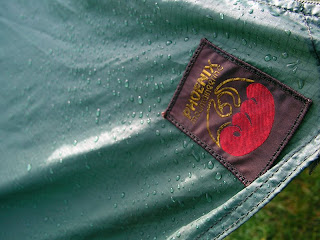
I've been using an Aquagear bottle from Drink-Safe Systems since last year and while it works well I found the capacity a little small for camping. I carried an Ortleib flexible water bag for camp use and usually filled it from the Aquagear bottle as late in the day as I dared but found it a bit troublesome trying to keep the Ortleib bag open and operate the Aquagear bottle. The other problem I had was that none of my rucksacks have bottle pockets that are accessible without removing the pack so that had me looking at flexible bladders/in pack hydration systems.
I'd seen the inline filters before so went to have another look and found the Eliminator Inline filter. What attracted me to it was the Q/D fitting for the filter which allows you to remove the filter from the system. The RRP is £46.95 but is currently available at a Launch offer price of £36.95.





After a few e-mails to Giles (Butler) of Drink-Safe Systems I placed my order and received the kit next day. I can recommend the service 100%, prompt replies to questions and prompt delivery.
The kit comes with 2 x Q/D fittings which are screwed into the filter housing, 4 x Screw in non Q/D fittings (2 different sizes) the Filter unit, instructions and an adapter which screws into the filter to allow you to;
a. Back Flush the Filter to maintain it
b. Attach the filter to a standard water tap to directly filter water.
Setting up the system is simplicity itself, it's fairly obvious and you could hardly go wrong but it does come with detailed instructions.

The first thing I did was to decide where to fit the filter on the feed tube, I decided to place mine mid way so that the filter was close to the feed tube port on the rucksack, this means you don't need to try to push both the bladder and filter down into a fully loaded rucksack, also if you want to use the filter as a gravity feed to fill a mug or pot you can unclip the feed tube at the outlet end of the filter thereby removing the bite valve and still have enough length left on the feed tube to allow it to hang outside the rucksack.

The next step was to flush the filter before fitting. To do this you attach one of the non-Q/D connectors to the Tap Adapter, screw the adapter to the filter taking care to screw it into the input end (there's a direction of flow arrow on the filter housing) attach it to a tap and flush it through, the instruction suggest flushing for 1 minute.

With the filter flushed it's time to fit the Q/D fittings, simply push the barbed section into the feed tube, unscrew the tap adapter and screw the Q/D fittings into the filter, (if you separate the 2 parts of the Q/D fittings prior to fitting to the feed tube/filter make sure that you match them properly so that the filter when connected is correctly orientated to the direction of flow. Once you've done that you're ready to roll.
The filter can be removed from the feed tube if not required, as the fittings are matched the feed tube can be joined clipped back together.
A couple of things I want to mention though:
a. The Q/D connectors aren't valved (sometimes known as 'Dry Break') which means that water can flow out of the feed tube if the filter is disconnected, with care this isn't too much of a problem.
b. The barbed end of the Q/D connector measures approx 7.5mm, I've tried them on a Camelbak Feed Tube and a Source Convertube feed tube and they fitted fine, some systems may have a feed tube with in ID greater than those mentioned so it's worth checking. In the event that your feed tube isn't a tight fit on the Q/D connectors a bit of PTFE (Plumbers) tape should sort it, if not you can always use the non Q/D fittings but with a little loss of usability.
All in all a nice system that's a bit easier to use IMO if you're going out for more than a 1 nighter. I'll probably still use the Aquagear bottle for day walks.
The Filter and Q/D connectors add about 100g to your existing Hydration system.
Full details of the various tests performed on the Drink-Safe Filtration Systems can be viewed Here












































